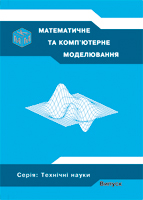ДО ПИТАННЯ ЗБІЖНОСТІ МОДИФІКОВАНОГО КОЛОКАЦІЙНО-ІТЕРАТИВНОГО МЕТОДУ РОЗВ’ЯЗУВАННЯ КРАЙОВИХ ЗАДАЧ ДЛЯ ЗВИЧАЙНИХ ДИФЕРЕНЦІАЛЬНИХ РІВНЯНЬ З ПАРАМЕТРАМИ
DOI:
https://doi.org/10.32626/2308-5878.2010-3.179-186Ключові слова:
крайова задача, диференціальні рівняння, інтегральне рівняння, колокаційно-ітеративний метод.Анотація
Розглядається питання застосування колокаційно-ітеративного методу до розв’язування крайових задач для звичайних диференціальних рівнянь з параметрами. Побудовано алгоритм методу, встановлено достатні умови його збіжності.Посилання
Самойленко A. M. Дифференциальные уравнения с импульсным воздействием / A. M. Самойленко, Н. А. Перестюк. – К. : Вища шк., 1987. – 287 с.
Лучка А. Ю. Проекційно-ітеративний метод для диференціальних рівнянь з обмеженнями / А. Ю. Лучка // Нелінійні коливання. – 2002. – Т. 5, № 4. – С. 465–488.
Ронто Н. И. Об одном методе исследования краевых задач с параметрами / Н. И. Ронто, В. А. Ронто // Краевые задачи математической физики. – К. : Наук. думка, 1990. – С. 3–10.
Бойчук А. А. Конструктивне методы анализа краевых задач / А. А. Бойчук. – К. : Наук. думка, 1990. – 96 с.
##submission.downloads##
Опубліковано
2010-03-10
Номер
Розділ
Статті
Ліцензія
Authors who publish with this journal agree to the following terms:- Authors retain copyright and grant the journal right of first publication with the work simultaneously licensed under a Creative Commons Attribution License that allows others to share the work with an acknowledgement of the work's authorship and initial publication in this journal.
- Authors are able to enter into separate, additional contractual arrangements for the non-exclusive distribution of the journal's published version of the work (e.g., post it to an institutional repository or publish it in a book), with an acknowledgement of its initial publication in this journal.
- Authors are permitted and encouraged to post their work online (e.g., in institutional repositories or on their website) prior to and during the submission process, as it can lead to productive exchanges, as well as earlier and greater citation of published work (See The Effect of Open Access).

